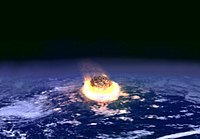
Photo from wikipedia
The Cretaceous–Palaeogene (K–Pg) mass extinction was responsible for the destruction of global ecosystems and loss of approximately three-quarters of species diversity 66 million years ago. Large-bodied land vertebrates suffered high… Click to show full abstract
The Cretaceous–Palaeogene (K–Pg) mass extinction was responsible for the destruction of global ecosystems and loss of approximately three-quarters of species diversity 66 million years ago. Large-bodied land vertebrates suffered high extinction rates, whereas small-bodied vertebrates living in freshwater ecosystems were buffered from the worst effects. Here, we report a new species of large-bodied (1.4–1.5 m) gar based on a complete skeleton from the Williston Basin of North America. The new species was recovered 18 cm above the K–Pg boundary, making it one of the oldest articulated vertebrate fossils from the Cenozoic. The presence of this freshwater macropredator approximately 1.5–2.5 thousand years after the asteroid impact suggests the rapid recovery and reassembly of North American freshwater food webs and ecosystems after the mass extinction.
Journal Title: Biology Letters
Year Published: 2022
Link to full text (if available)
Share on Social Media: Sign Up to like & get
recommendations!